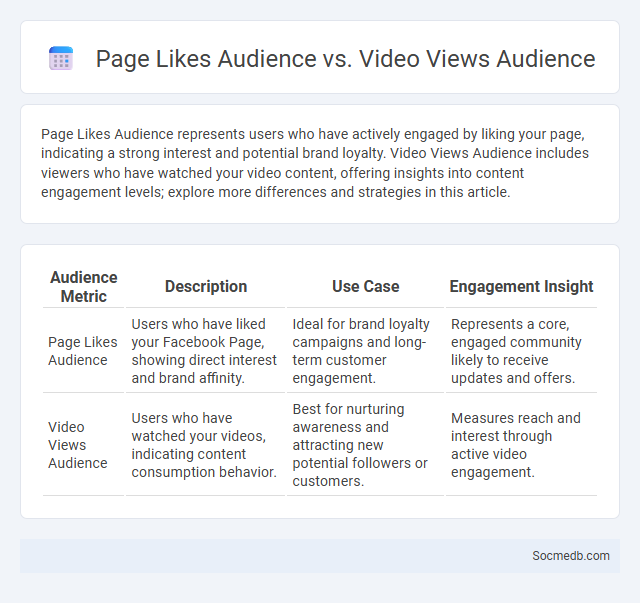
Photo illustration: Page Likes Audience vs Video Views Audience
Page Likes Audience represents users who have actively engaged by liking your page, indicating a strong interest and potential brand loyalty. Video Views Audience includes viewers who have watched your video content, offering insights into content engagement levels; explore more differences and strategies in this article.
Table of Comparison
| Audience Metric | Description | Use Case | Engagement Insight |
|---|---|---|---|
| Page Likes Audience | Users who have liked your Facebook Page, showing direct interest and brand affinity. | Ideal for brand loyalty campaigns and long-term customer engagement. | Represents a core, engaged community likely to receive updates and offers. |
| Video Views Audience | Users who have watched your videos, indicating content consumption behavior. | Best for nurturing awareness and attracting new potential followers or customers. | Measures reach and interest through active video engagement. |
Understanding Page Likes Audience
Analyzing your page likes audience provides valuable insights into their demographics, interests, and online behavior, which helps tailor content effectively. Tools like Facebook Audience Insights or Instagram Analytics reveal patterns such as age, location, and engagement rates, enabling precise targeting. Utilizing this data maximizes reach and boosts interaction, ensuring your social media strategy aligns with your audience's preferences.
Defining Video Views Audience
Video views audience refers to the segment of users who actively watch video content across social media platforms such as Facebook, Instagram, TikTok, and YouTube. Understanding this audience involves analyzing metrics like view duration, engagement rate, and demographic data to optimize content strategy and targeting. Identifying viewer behavior and preferences enables marketers to tailor campaigns that enhance reach, retention, and conversion rates effectively.
What is a Target Audience?
A target audience refers to a specific group of consumers identified as the intended recipients of a social media marketing campaign or content. This group is defined by demographic factors such as age, gender, location, interests, and online behavior, enabling brands to tailor messages that resonate effectively. Understanding the target audience improves engagement, increases conversion rates, and maximizes the return on investment in social media advertising.
Key Differences Between Audiences
Audiences on social media differ significantly in demographics, preferences, and engagement behaviors, influencing the effectiveness of content strategies. Platforms like Instagram attract younger users seeking visual storytelling, while LinkedIn appeals to professionals interested in industry insights and networking. Understanding these key differences helps tailor your messaging to resonate with your target audience and maximize interaction.
How Page Likes Influence Engagement
Page Likes significantly impact social media engagement by increasing the visibility of your content within users' feeds, thereby enhancing interaction rates such as comments, shares, and reactions. The higher the number of Likes, the greater the perceived credibility and popularity of your page, which encourages more users to engage actively with your posts. You can leverage this influence by strategically encouraging Likes to boost organic reach and foster a more engaged online community.
Video Views and Their Audience Behavior
Video views on social media platforms provide critical data on audience engagement and preferences, revealing patterns in user behavior such as watch time, repeat views, and interaction rates. Analyzing metrics like completion rate and drop-off points helps marketers tailor content to increase retention and drive conversions. Audience behavior also varies by demographic factors, influencing optimal video length, format, and posting time to maximize reach and impact.
Target Audience: Precision and Impact
Understanding your target audience on social media allows you to tailor content that resonates deeply, maximizing engagement and conversion rates. Leveraging analytics tools helps identify demographic details, interests, and behaviors, enabling precision in ad targeting and message crafting. Your campaigns achieve greater impact when aligned closely with the specific needs and preferences of your audience segments.
Advantages and Limitations of Each Audience Type
Social media platforms offer distinct advantages and limitations depending on their audience types; for example, Instagram excels with younger demographics through visually rich content, driving high engagement but limiting textual depth. Facebook targets a broader age range, fostering community interaction and detailed discussions, yet faces challenges with declining organic reach and privacy concerns. Understanding these nuances helps you tailor content effectively to maximize impact across each platform's unique audience.
Best Practices for Audience Targeting
Effective audience targeting on social media requires detailed demographic analysis and behavioral segmentation to tailor content precisely. Leveraging data analytics tools like Facebook Audience Insights and Google Analytics enhances targeting accuracy by identifying user preferences and engagement patterns. Consistent testing and refining of ad campaigns based on performance metrics ensure optimized reach and higher conversion rates.
Choosing the Right Audience for Your Goals
Selecting the right audience for your social media campaigns is critical to maximizing engagement and achieving your marketing goals. Understand your target demographic by analyzing data such as age, interests, location, and online behavior to tailor your content effectively. You can enhance conversion rates and build a loyal community by focusing on the audience segments most aligned with your brand's objectives.
 socmedb.com
socmedb.com